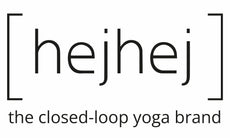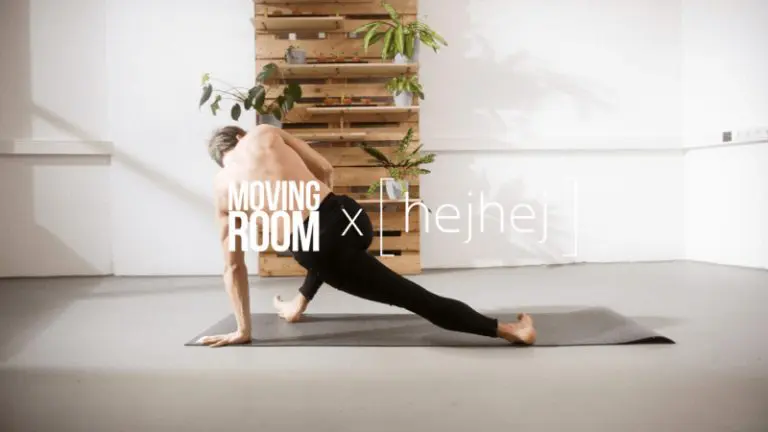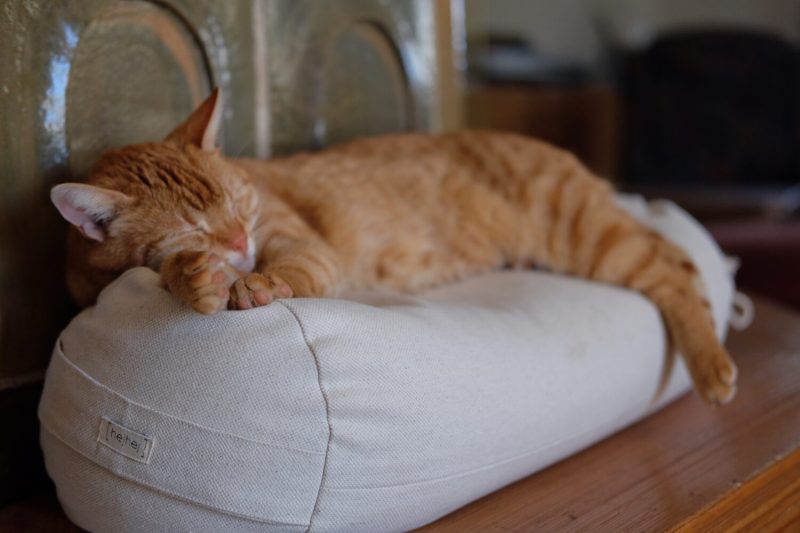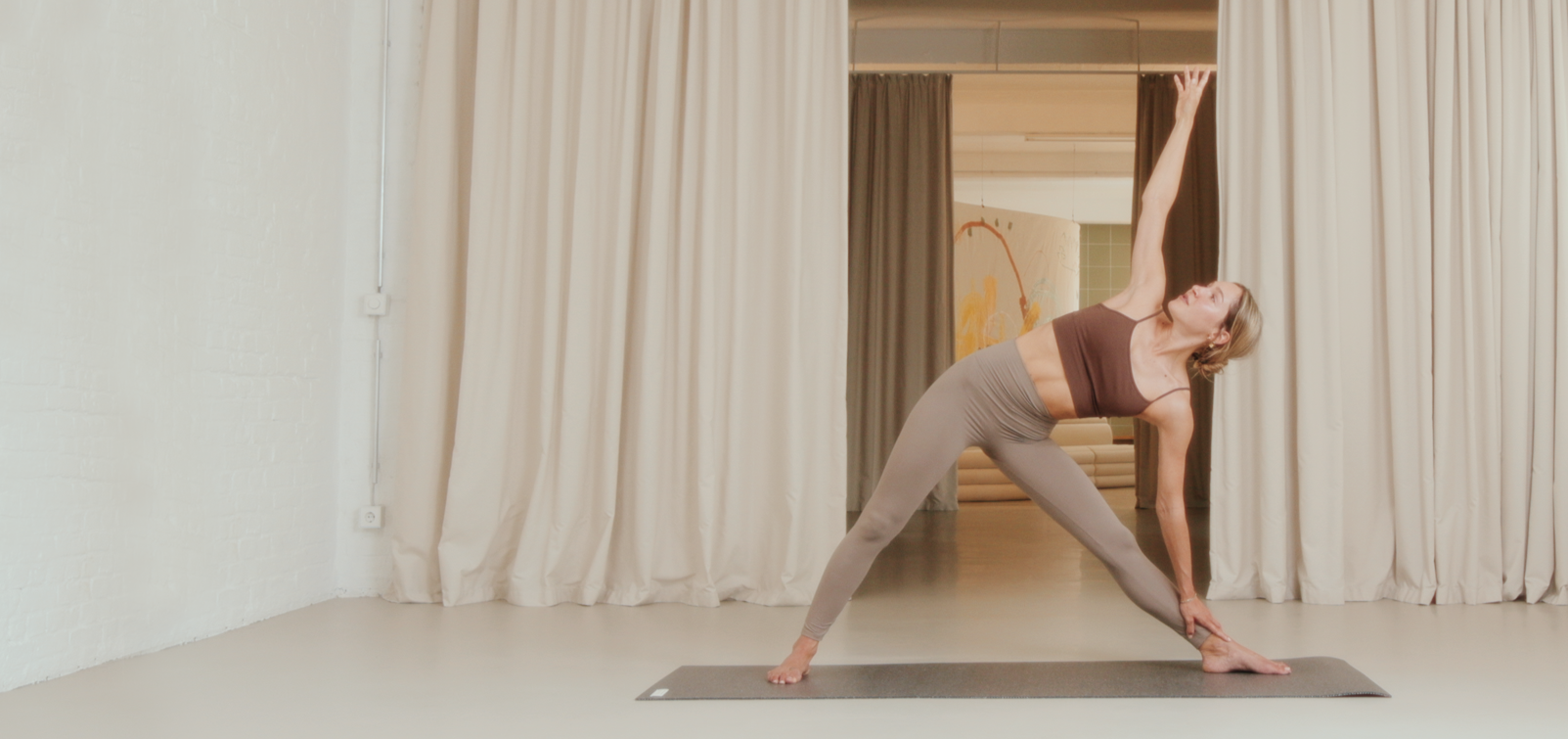Yoga unites movement and stillness. As there is quietude and excitement within yourself, you’ll find both in your yoga practice, too. In our blog post about yin yoga asanas on the hejhej-bolster we focussed on relaxation and slow movement. This blog post is about 4 playful asanas you can do with your hejhej-bolster, hejhej-strap and block that are more on the more powerful yang side of yoga. Where there is yin, there is yang. Let’s play with our yoga equipment today so that we got to re-discover familiar asanas.
1. Pigeon with a strap
You might know the pigeon pose as the swan in yin yoga. Kapotasana is a hip-opening backbend. It is easiest to enter pigeon pose from downward-facing dog. From there, let one of your knees sink between your hands, stretch the other leg out on your mat. Anchor your hands firmly on your mat so that you get to arrive in your variation of pigeon pose safely and gently. When practicing with equipment, you get to rest the lifted side of your bottom on your yoga pillow. By doing so, you relax the opening of your hip and might be able to move your shin a little more parallel to the shorter side of your mat. While doing so, mind the wellbeing of all your joints. This should all feel fine. Have you tried resting on the bolster in pigeon pose before? While at it, keep your hips facing forward. Now try lifting the sole of your feet towards your shoulder blades. How does that feel in your front thigh? Good? Then why not add the strap! Lay it around your foot, just below your toes. Then step by step, let your hands wander along the strap towards your foot. Breathe deeply towards the stretching in your front thigh as well as your lower back that might be challenged right now. Go as deep as you wish today.

2. Gentle bow
The bow can be a challenging pose for your back. At the same time, the asana strengthens your spine and stretches your forefront. That is why the bow pose does an incredible job in improving your posture. It is an ideal counter-movement to all those actions you do in front of your body – basically all of them. Dhanurasana rewards you with self-esteem, focus, and a clear mind. The hejhej-bolster allows you to practice a smoother bow while still enjoying the full mental benefits of it. Start moving into your gentle bow pose from the cobra pose. In Bhujangasama, pull the bolster below your navel, just below your ribcage, then rest your upper body on it. Bend your legs and lay your hands around your ankles. Voilà, a gentle bow. Stay in this asana, as long as your back enjoys it.

3. Balance-Challenge in tabletop pose
Get into your tabletop pose. Hands underneath your shoulders, knees underneath your hips. You might know the balancing exercise where you diagonally lift arms and legs. Do you? To really flow it is ideal to move with your breath. Inhale: Stretch out, connect with your core. Exhale: Round your spine, elbow and knee meet below your navel. Try adding the hejhej-bolster to your movement. On the one side, your knee is heavenly comfortable, on the other side, you get to challenge your concentration and balancing skills. Try deepening your breath to move as controlled as possible. The bolster helps you bring your focus onto your mat, back to your body, your breath, your asana. Give it a try, will you?
How did the hejhej-bolster feel below your knee? Why not add it to other poses, too? Be gentle with your joints. Be loving towards yourself.

4. Crocodile on the hejhej-bolster
Most yoga poses really benefit from a strong body’s center. Getting into a handstand, Sirsasana, safely or staying in Navasana, boat pose, for example. Your abdominal muscles are the direct opponent of your back muscles. Did you know that? They need eachother. The stronger your tummy- and spinal muscles, the less likely it is for you to suffer from back pain or even herniated disks. The crocodile exercises in your yoga practice do just that: Strengthening your center, your core.
Rest your back on your hejhej-bolster and make sure that your lower back as well as your shoulder girdle touches the yoga pillow. Head and neck may additionally rest on a yoga block. Make sure to lengthen and relax your neck, too. Start the exercise by lifting your arms and legs towards the ceiling, bending your knees at a 90° angle. Flex your feet, pull the toes towards your knees, stretch out your fingertips. Are the lower back and shoulder girdle still in contact with the bolster? Now, in turns, stretch your right leg and left arm, and then your left leg and right arm and let them sink toward the mat. Move diagonally, consciously move with your breath, feel your core engaging. Breathe deeply into your tummy. Can you feel your core strength? Eventually bring both knees towards your chest. Hug yourself, enjoy resting.

Want to know more about our hejhej-bolster? Our credo during the phase of development was ‘small things matter’. Please have a look at our documentation!
Brand new we also have some yoga flows with the hejhej-bolster on our youtube channel. Try directly the restorative yoga to feel safe | 20 min (english), Blind Yoga morning routine | 20 min | gentle mobilisation | for blind and sighted yogi:nis (german) or the Prenatal Yoga 3rd trimester | 30 min (german) and also for all non-pregnant women! Viel Freude beim Praktizieren!




